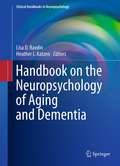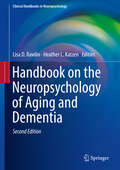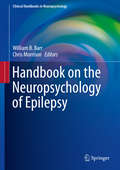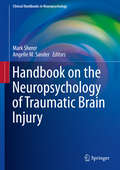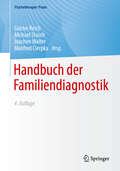- Table View
- List View
Handbook on the Neuropsychology of Aging and Dementia
by Heather L. Katzen Lisa D. RavdinWith the aging of the baby boomers and medical advances that promote longevity, older adults are rapidly becoming the fastest growing segment of the population. As the population ages, so does the incidence of age related disorders. Many predict that 15% - 20% of the baby-boomer generation will develop some form of cognitive decline over the course of their lifetime, with estimates escalating to up to 50% in those achieving advanced age. Although much attention has been directed at Alzheimer's disease, the most common form of dementia, it is estimated that nearly one third of those cases of cognitive decline result from other neuropathological mechanisms. In fact, many patients diagnosed with Alzheimer's disease likely have co-morbid disorders that can also influence cognition (i.e., vascular cognitive impairment), suggesting mixed dementias are grossly under diagnosed. The Clinical Handbook on the Neuropsychology of Aging and Dementia is a unique work that provides clinicians with expert guidance and a hands-on approach to neuropsychological practice with older adults. The book will be divided into two sections, the first addressing special considerations for the evaluation of older adults, and the second half focusing on common referral questions likely to be encountered when working with this age group. The authors of the chapters are experts and are recognized by their peers as opinion leaders in their chosen chapter topics. The field of neuropsychology has played a critical role in developing methods for early identification of late life cognitive disorders as well as the differential diagnosis of dementia. Neuropsychological assessment provides valuable clinical information regarding the nature and severity of cognitive symptoms associated with dementia. Each chapter will reinforce the notion that neuropsychological measures provide the clinician with sensitive tools to differentiate normal age-related cognitive decline from disease-associated impairment, aid in differential diagnosis of cognitive dysfunction in older adults, as well as identify cognitive deficits most likely to translate into functional impairments in everyday life.
Handbook on the Neuropsychology of Aging and Dementia (Clinical Handbooks in Neuropsychology)
by Heather L. Katzen Lisa D. RavdinThis comprehensive update offers practical advice for professionals working in neuropsychology with older adults. Focusing on fundamentals, common issues, special considerations, and late-life cognitive disorders, respected names in this critical specialty address a wide range of presenting problems and assessment, diagnostic, and treatment concerns. Th roughout, coverage pays keen attention to detail, bringing real-world nuance to large-scale concepts and breaking down complex processes into digestible steps. And like its predecessor, the new Handbook features recommendations for test batteries and ends each chapter by extracting its “clinical pearls.” <P><P>This Second Edition of the Handbook on the Neuropsychology of Aging and Dementia offers a wealth of expert knowledge and hands-on guidance for neuropsychologists, gerontologists, social workers, and other clinicians interested in aging. Th is can be a valuable reference for those studying for board certifi cation in neuropsychology as well as a resource for veteran practitioners brushing up on key concepts in neuropsychology of age related disorders.
Handbook on the Neuropsychology of Epilepsy
by William B. Barr Chris MorrisonThis up-to-date resource offers clinicians a skills-based framework for assessment and treatment of cognitive and emotional problems associated with epilepsy, using current evidence and standardized terminology. Expert coverage reviews widely-used methods for evaluating key aspects of patient functioning (MRI, MEG, electrocortical mapping, the Wada test), and presents guidelines for psychotherapeutic and cognitive remediation strategies in treating comorbid psychiatric conditions. Given the diversity of the patient population, additional chapters spotlight issues specific to subgroups including high- and low-functioning as well as geriatric and pediatric patients. This integrative hands-on approach benefits novice and veteran practitioners across medical and neurological settings seeking guidance on testing, treatment planning, and surgery-related concerns. Topics featured in the Handbook: Neuropsychological assessment across the lifespan. Evaluating the epilepsy surgical candidate: methods and procedures. The Wada test: current perspectives and applications. Assessing psychiatric and personality disorders in the epilepsy patient. Evaluation and management of psychogenic non-epileptic attacks. Neuropsychological assessment with culturally diverse patients. Practical and flexible in its coverage, the Handbook on the Neuropsychology of Epilepsy serves not only neuropsychologists and neurologists but also primary care physicians such as internists, family physicians, and pediatricians.
Handbook on the Neuropsychology of Traumatic Brain Injury
by Mark Sherer Angelle M. SanderThis book collects and synthesizes the latest thinking on the condition in its variety of cognitive and behavioral presentations, matched by a variety of clinical responses. Acknowledging the continuum of injury and the multi-stage nature of recovery, expert contributors review salient research data and offer clinical guidelines for the neuropsychologist working with TBI patients, detailing key areas of impairment, brief and comprehensive assessment methods and proven rehabilitation strategies. Taken together, these chapters provide a framework for best serving a wide range of TBI patients (including children, elders, and patients in multidisciplinary settings) and model treatment that is evidence-based and relevant. A sample of the topics featured in the Handbook: Bedside evaluations in TBI. Outcome assessment in TBI. Collaborating with family caregivers in the rehabilitation of persons with TBI. Behavioral assessment of acute neurobehavioral syndromes to inform treatment. Pediatric TBI: assessment, outcomes, intervention. Special issues with mild TBI in veterans and active duty service members. Expanding professional knowledge on a topic that continues to grow in importance, the Handbook on the Neuropsychology of Traumatic Brain Injury is a premier resource, not only for neuropsychologists but also for other professionals in cognitive care, and trainees entering the field.
Handbuch Angewandte Psychologie für Führungskräfte: Führungskompetenz und Führungswissen
by Eric Lippmann Andres Pfister Urs Jörg Tobias LeuenbergerDas erfolgreiche Handbuch für Praktiker - bislang bekannt als "der Steiger-Lippmann" - fasst das gesamte, für Führungskräfte aller Ebenen relevante Wissen der Psychologie in einem Werk zusammen und ist, nun schon in der 5. Auflage mit neuem Herausgeberteam, ein bewährter Wegweiser in allen Führungssituationen, wie ein Blick auf die Themen des Buches zeigt: Leistungsbeeinflussung, Führung der eigenen Person, Kommunikation, Teamführung, Recruiting, Personalentwicklung, Motivation, Projektmanagement, Change Management, Konfliktmanagement, Coaching u.v.m. - all das funktioniert im Alltag nicht ohne Know-how aus der Psychologie! Auch zeitaktuelle Themen wie Umgang mit Verhaltensauffälligkeiten, Burnout etc., Managing Diversity, Virtuelle Führung oder Einsatz von Social Media u.a. sind enthalten.Eine sorgfältige didaktische Aufbereitung des Textes mit Checklisten, Fallbeispielen, Leitfragen, Arbeitsblättern u.a. erleichtert das Lesen.Herausgeber und Autoren sind erfahrene Praktiker in der Führungskräfteentwicklung und Dozenten am renommierten IAP Institut für Angewandte Psychologie in Zürich.
Handbuch Arbeits- und Gesundheitsschutz
by Institut für angewandte ArbeitswissenschDieses Handbuch dient als Praxisleitfaden für Arbeits- und Gesundheitsschutzbeauftragte. Es gibt Hilfestellung beim Aufbau der Organisation des betrieblichen Arbeits- und Gesundheitsschutzes. Dies soll Unternehmen dazu befähigen, basierend auf den gesetzlichen Anforderungen ein zum jeweiligen Betrieb passendes System zu installieren. Neben der rechtlichen Einordnung beschreiben die Autoren in kleinen Schritten und praxisgerecht die erforderlichen planerischen und organisatorischen Aspekte. Das Handbuch enthält Vorlagen und Checklisten. Diese können direkt verwendet und auf die eigenen betrieblichen Belange angepasst werden. Unternehmen, die das Handbuch nutzen und mit Leben füllen, haben damit die Grundlage für ein Arbeitsschutzsystem geschaffen, dass zu einem Arbeitsschutzmanagement ausgebaut werden kann. Dieses Handbuch wird Betriebspraktiker interessieren, ihnen hilfreiche Impulse für die eigene Arbeit sowie für die Umsetzung vor Ort geben.
Handbuch Digitale Gesundheitswirtschaft: Analysen und Fallbeispiele
by Sabine Bohnet-Joschko Katharina PilgrimDas Handbuch digitale Gesundheitswirtschaft liefert eine qualitätsgeprüfte umfassende Übersicht zu Chancen und Herausforderungen der digitalen Transformation des Gesundheitswesens. Dabei werden Technologien, regulatorischer Rahmen, innovative Geschäftsmodelle und Einsatzbereiche jeweils mit branchenrelevanten Fallbeispielen ergänzt. Sowohl ökonomische als auch versorgungsrelevante Aspekte werden diskutiert - anhand aktueller wissenschaftlicher internationaler Studien.
Handbuch Emotionsregulation: Zwischen psychischer Gesundheit und Psychopathologie
by Sven BarnowDieses Handbuch gibt einen fundierten Überblick über das aktuelle Wissen zum Thema Emotionsregulation. Grundlagen- und Anwendungswissen werden zusammengeführt, so dass Forscher/innen und Praktiker/innen den aktuellen Wissensstand nachlesen und sich an den neusten Befunden orientieren können. Geschrieben für alle, die sich einen umfassenden Überblick zum Thema Emotionsregulation verschaffen wollen (u. a. Psychologische und Ärztliche Psychotherapeut/inn/en, Psychiater/innen und Ärzte für Psychosomatische Medizin, Student/inn/en der Psychologie und Medizin, Wissenschaftler/innen mit Fokus Emotionsregulation). Aus dem Inhalt: I Modelle, Konzepte und Messung von Emotionsregulation (ER) – II Genetik und Neurobiologie der ER – III Schnittstelle Kognition und ER – IV Interpersonelle ER (ER im Kontext von Dyaden und Gruppen) – V ER bei psychischen Störungen und in der Psychotherapie – VI Zusammenfassung und Implikationen für Forschung und Praxis. Der Herausgeber: Prof. Dr. Sven Barnow leitet den Lehrstuhl für Klinische Psychologie und Psychotherapie am Psychologischen Institut der Ruprecht-Karls-Universität Heidelberg. Er hat eine Vielzahl von wissenschaftlichen Publikationen und mehrere Bücher verfasst. Seine Forschung zur Emotionsregulation beinhaltet u. a. die Grundlagen, Messung und Bedeutung der Emotionsregulation für psychische Gesundheit und Psychopathologie.
Handbuch Ernährungskommunikation
by Angela Mörixbauer Marlies Gruber Eva DerndorferDie Flut an Informationen rund um Ernährung und Lebensmittel führt zu Verwirrung und Verunsicherung, sowohl bei Verbrauchern als auch Fachpersonal. Um erfolgreich seine Botschaften an die jeweilige Zielgruppe zu bringen, bedarf es des Verständnisses über die komplexen Zusammenhänge, Kommunikationsmöglichkeiten, Intentionen der unterschiedlichen Akteure, der differenzierten Ansätze je nach Zielgruppe, Ansprüche an die unterschiedlichen Kanäle sowie der Feinheiten des Kommunikationsmittels.
Handbuch Essstörungen und Adipositas
by Stephan Herpertz Stephan Zipfel Martina De ZwaanIn diesem Buch wird das gesamte Spektrum der Essstörungen, inklusive der Adipositas, schulenunabhängig und basierend auf den neuesten Therapieleitlinien behandelt. Alle Störungsbilder werden auf Grundlage der aktuellen Datenlage erläutert; Behandlungswege werden aufgezeigt, die psychotherapeutische und ergänzende pharmakologische Interventionen verknüpfen, um den Therapeutinnen und Therapeuten klare Handlungsempfehlungen zu geben.Die 3. Auflage wurde vollständig überarbeitet und um wichtige aktuelle Themen und Kapitel ergänzt, wie z. B. die Eingliederung der Essstörungen in ICD 11/DSM 5, die Rolle des Mikrobioms und den Einsatz moderner Medien in Prävention und Therapie. Des Weiteren greifen Herausgeber und Autoren u.a. die systemische Therapie als neue Richtlinienpsychotherapie und die Diskussion rund um Suchtmechanismen bei Ess- und Gewichtsstörungen auf und geben einen Ausblick auf die Rolle der Neurostimulationsverfahren, um aktuellen Entwicklungen im Bereich Adipositas und Essstörungen Rechnung zu tragen.Als Nachschlagewerk ist das Buch sowohl für angehende Ärzte, Pädagogen und Psychologen, insbesondere Psychosomatiker, Psychiater und Psychotherapeuten in Klinik und Praxis geeignet.
Handbuch Gestaltung digitaler und vernetzter Arbeitswelten (Springer Reference Psychologie Ser.)
by Gregor Engels Günter W. Maier Eckhard SteffenDieses interdisziplinäre Handbuch richtet sich an all diejenigen, die den digitalen Wandel, der im Zusammenhang mit der vierten industriellen Revolution (Industrie 4.0) diskutiert wird, in Betrieben, Verwaltungen und der Gesellschaft besser verstehen und aktiv gestalten möchten. Die einzelnen Beiträge veranschaulichen die vielfältigen Perspektiven unterschiedlicher Disziplinen (z.B. Ingenieur-, Rechts- und Wirtschaftswissenschaften, Informatik, Psychologie, Soziologie, Erziehungswissenschaft u.a.) oder Interessensgruppen (z.B. Gewerkschaften) auf die Folgen der Digitalisierung im Arbeitsleben für Mensch, Organisation und Gesellschaft. Das gesamte Werk schlägt eine Brücke von aktuellen Forschungsergebnissen hin zu praktischen Umsetzungshinweisen. Im Zentrum stehen drei zentrale Fragen zur Digitalisierung des Arbeitslebens, und zwar woran man sich bei der Gestaltung orientieren, wie die Transformation gestaltet werden und worauf sich die Digitalisierung auswirken kann. Beispielthemen dieser 3 Bereiche: 1. Im Zusammenhang mit den Gestaltungskriterien: sichere und gesundheitsförderliche Gestaltung der digitalen Arbeitsweltarbeitsrechtliche Aspektepsychologische Arbeitsgestaltung digitaler Arbeitswelten 2. Im Zusammenhang mit der Art und Weise des Wandels von analogen zu digitalen Arbeitswelten: Chancen für gesundheitsorientierte Arbeitsgestaltung durch körpernahe und tragbare Sensorik neue Aufgabenverteilung durch kollaborative Roboter im Rahmen der Mitbestimmung Prozesse durch proaktive betriebliche Interessensvertretung gestalten 3. Im Zusammenhang mit den Konsequenzen: Auswirkungen digitaler Arbeitswelten auf die Beschäftigungsstrukturen und das Privatleben Möglichkeiten dieser Entwicklung für die Inklusion älterer Menschen oder Menschen mit Behinderung ZielgruppenAnwender/innen und Entwickler/innen digitaler Technologien, Führungskräfte, Personalleiter/innen und Entscheidungsträger/innen in Unternehmen, Verbänden und der Politik
Handbuch Gesundheitssoziologie (Springer Reference Sozialwissenschaften Ser.)
by Monika Jungbauer-Gans Peter KriwyDas Handbuch leistet einen Überblick zu zentralen Themen der Gesundheitssoziologie. Die Abschnitte berücksichtigen dabei die Ebene der handelnden Akteure (Mikroebene), die Mesoebene der Organisationen sowie die Makroebene der Gesundheitssysteme und Gesundheitspolitik. Zudem werden internationale Vergleiche aufgezeigt. Ziel der einzelnen Beiträge ist es, sowohl die theoretischen Grundlagen eines Themas darzustellen als auch eine Übersicht zum Forschungsstand zu liefern. Die Beiträge eignen sich daher insbesondere für eine Einführung in die Themen im Rahmen der Lehre, aber auch als Ausgangspunkt für vertiefende Forschung. Zielgruppen des Handbuchs sind Forschende und Studierende der Soziologie mit Schwerpunkt Gesundheitsforschung, Gesundheits- und Medizinsoziologie, Public Health, Sozialen Arbeit, Epidemiologie, Sozialpsychologie oder der angrenzenden Disziplinen im Themenfeld Gesundheit.
Handbuch Klinisches Risikomanagement: Grundlagen, Konzepte, Lösungen - medizinisch, ökonomisch, juristisch (Erfolgskonzepte Praxis- & Krankenhaus-Management)
by Alexander EuteneierMinimieren Sie Ihre Risiken mit klinischem Risikomanagement.Klinisches Risikomanagement und Patientensicherheit sind unverzichtbare Bestandteile ärztlichen und pflegerischen Handelns.Experten erläutern Grundlagen, zeigen praktische Lösungen und stellen Werkzeuge vor wie: Checklisten, Standard Operating Procedures, Critical Incident Reporting-Systeme, Mortalitäts- & Morbiditäts-Konferenzen, Peer Reviews, Ursachenanalysen wie dem London Protokoll, Simulationen und Szenarioanalysen, Einsatz von Qualitätsindikatoren und Patientensicherheitsindikatoren sowie Risiko-Audits. Erfassen und bewerten Sie Risiken mit Qualitäts- und Patientensicherheitsindikatoren unter Verwendung anerkannter Risikomanagementnormen wie der ISO-Norm 31000. Das vollständig überarbeitete und erweiterte Handbuch deckt Themen ab wie: Führung, Strategieentwicklung, Teamentwicklung, Mitarbeitermotivation, Organisationales Lernen, Etablierung einer Sicherheitskultur. Und greift aktuelle Themen wie Digitalisierung, neueste Human Factor-Forschungen und die Rolle der Architektur für Patientensicherheit auf.Es werden sowohl medizinische, managementbezogene, ökonomische, psychologische, juristische als auch technische Themen angesprochen, um den Lesern alles an die Hand zu geben, um ein effizientes Risikomanagement - am eigenen Bedarf orientiert - zu implementieren. Es richtet sich an Entscheidungsträger und Führungskräfte sowie an die vielen Umsetzer vor Ort, wie Geschäftsführer, Ärztliche Direktoren, Pflegedirektoren, Chefärzte, Oberärzte, Pflegedienstleitungen, Stationsleitungen, Risikomanager, Patientensicherheitsbeauftragte, Qualitätsmanager- und -beauftragte, Personalmanager, Hygienemanager und -beauftragte, IT-Führungskräfte, Apotheker, Medizintechniker, Bautechniker, Krisenmanager und Juristen.
Handbuch Krankenhausrestrukturierung: Außergerichtliche und gerichtliche Sanierungswege
by Rainer EckertDas Handbuch liefert einen systematischen Überblick und inhaltlichen Tiefgang über die wirtschaftlichen, rechtlichen und tatsächlichen Herausforderungen von Krankenhausrestrukturierungen. Die in der juristischen Literatur bestehenden Lücken werden geschlossen und alle relevanten Umstände umfassend behandelt. Das Werk dient insbesondere der Praxis, ohne aber auf eine wissenschaftliche Aufarbeitung zu verzichten.
Handbuch Medizinökonomie I: Grundlagen und System der medizinischen Versorgung
by Christian ThielscherMedizinökonomie ist die Anwendung ökonomischer Methoden auf die Medizin, insbesondere auf die medizinische Versorgung. Ihr Ziel ist die Verbesserung der medizinischen Behandlung, denn die erfolgreiche Behandlung gilt in der Medizin wie in der Medizinökonomie als oberste Maxime professionellen Handelns. Der wissenschaftliche ebenso wie der praxisbezogene Austausch von Wirtschaft und Medizin gestaltet sich aufgrund der manchmal uneinheitlichen Sicht auf die Dinge schwierig und führt nicht selten zu Missverständnissen. Die Autorinnen und Autoren liefern in diesem Handbuch eine fachlich abgesicherte und zugleich anwendungsbezogene Darstellung der medizinökonomisch relevanten Themenfelder und ermöglichen damit einen fundierten Überblick über den Status quo und die aktuellen Fragen des deutschen Gesundheitssystems.Der erste Band der „Handbuchreihe Medizinökonomie“ widmet sich den medizinökonomischen Grundlagen, stellt das System der Versorgung und ihre Akteure vor, erläutert ausgewählte neue Versorgungsformen und skizziert das Feld der Pflege und anderer Gesundheitsberufe.
Handbuch Positive Gesundheit in der Hausarztpraxis: Gemeinsam an einer sinnvollen Versorgung arbeiten
by Machteld Huber Hans Peter Jung Karolien van den Brekel-DijkstraImmer mehr Ärzte entdecken die vielen Vorteile, die die Arbeit mit dem Konzept der Positiven Gesundheit bringt. Es hilft, auf eine neue Weise mit Patienten zu sprechen: Im Mittelpunkt stehen die Ressourcen, das, was möglich ist, nicht das, was aufgrund einer Erkrankung unmöglich ist. Dieser Perspektivwechsel eröffnet nicht nur Patienten neue Sichtweisen, auch Hausärzte profitieren davon.Das Buch gibt zahlreiche Tipps, erzählt die Entstehungsgeschichte des Modells und beschreibt Beispiele aus der Praxis. Es erklärt die wissenschaftlichen Grundlagen von Positiver Gesundheit, wobei der Schwerpunkt immer darauf liegt, was für den Patienten von Bedeutung ist. Aber vor allem lädt Sie das Buch dazu ein, Positive Gesundheit im Sprechzimmer, in der Praxisorganisation und im Quartier einzuführen. Denn gerade in der Kooperation und dem gemeinsamen Bemühen liegt die Kraft dieser neuen Herangehensweise. Sie erfahren, wie Positive Gesundheit nahtlos an die Kernwerte und Herausforderungen der Allgemeinmedizin anknüpft. Das Handbuch wendet sich sowohl an Professionelle in und um die Hausarztpraxis, als auch an diejenigen, die noch in der Ausbildung sind. Es beschreibt das niederländische Gesundheitssystem und welche Erfahrungen dabei gemacht wurden, für das Konzept der Positiven Gesundheit zu begeistern und dieses im System zu verankern. Diese Publikation ist daher unentbehrlich für jeden, der mit Positiver Gesundheit zur Verbesserung der hausärztlichen Versorgung beitragen will.
Handbuch Stabsarbeit: Führungs- und Krisenstäbe in Einsatzorganisationen, Behörden und Unternehmen
by Gesine Hofinger Rudi HeimannStabsarbeit effizient und effektiv gestalten!Diese erweiterte, komplett überarbeitete Neuauflage des Handbuchs zur Stabsarbeit bietet einen anwenderorientierten Überblick über die Arbeit von Führungs- und Krisenstäben, ihre Voraussetzungen und Erfolgsbedingungen. Basierend auf der Expertise eines interdisziplinären Autorenteams erhalten Sie alle wichtigen Grundlagen, Prozesse und Strategien der Stabsarbeit zur Bewältigung komplexer Schadenslagen oder Einsatzsituationen. Zudem werden Fallbeispiele aus verschiedenen Bereichen vorgestellt.Zum InhaltGrundlagen der Stabsarbeit: Konzepte, Formen, Historie und ethische AspekteStabsarbeit in den Bereichen Militär, Polizei, Feuerwehr, Katastrophenschutz, Störfall- & Prozessindustrie, Verwaltung, Unternehmen, Krankenhaus, Schule und PolitikFühren und Entscheiden im Stab: Planung und Kontrolle, Lagebesprechungen, Beurteilen, Entscheiden und Entscheidungshilfen, Stress und StressbewältigungKommunikation und InformationsflüssePersonalauswahl, Ausbildung und Training von StäbenKonzepte und Gestaltung von StabsräumenSchnittstellen zwischen verschiedenen Stäben und FunktionenFallbeispiele aus der Praxis von KrisenstäbenDie ZielgruppenPersonalleitungen und Führungskräfte, Stabsmitglieder und Entscheider an der Spitze eines Stabes aus behördlichen oder privatwirtschaftlichen Bereichen, Verantwortliche im Katastrophenschutz, Notfall- und Krisenmanagement.Die HerausgeberDr. Gesine Hofinger ist Diplom-Psychologin, Partnerin von Team HF – Human Factors Forschung Beratung Training sowie wissenschaftliche Mitarbeiterin an der Universität Jena. Sie forscht im Bereich Bevölkerungsschutz und publiziert zu Stabsarbeit und Human-Factors-Psychologie. Sie bildet Krisenstäbe aus, ist an der Durchführung und Beobachtung von Stabsübungen aktiv beteiligt und führt After Action Reviews mit Stäben durch. Sie ist Vorsitzende der Plattform „Menschen in komplexen Arbeitswelten“ e. V.Rudi Heimann ist Polizeivizepräsident, zuvor Leiter einer zentralen Ausländerbehörde und in unterschiedlichen Führungsfunktionen in der hessischen Polizei tätig, währenddessen Polizeiführer und Leiter Führungsstab. Lehrtätigkeit in Kriminologie, Führungslehre und polizeiliches Einsatzmanagement an der Fachhochschule der Polizei in Hessen sowie Gastdozent u. a. an der Deutschen Hochschule der Polizei. Kommentierung der bundesweiten PDV 100 VS-NfD- Führung und Einsatz der Polizei. Spezialisiert auf Entscheidungsfindung und Stabsarbeit. Zahlreiche Publikationen mit Themenbezug. Vorstandmitglied der Plattform „Menschen in komplexen Arbeitswelten“ e. V.
Handbuch Strategisches Krankenhausmanagement
by Helmut Siller Jürgen Stierle Manfred Fiedler Sonja OrtnerDieser Sammelband beleuchtet vorrangig strategische, politische und normative Aspekte sowie Fragen aus dem Krankenhausalltag. Die Autoren – Ärzte, Hochschullehrer, Controller, Gesundheitscoaches, Psychologen, Marketing-Fachleute und Führungskräfte in Kliniken aus Österreich, Italien und Deutschland – sind erfahrende Praktiker mit gesundheitswissenschaftlichem Hintergrund. Ihre Beiträge liefern konkrete organisatorische, psychologische und betriebswirtschaftliche Methoden, um den Weg vom Ist zum Soll erfolgreich gestalten zu können. Damit bietet das Handbuch Führungssupport für alle aktiven und potenziellen Führungskräfte in Organisationen, die Gesundheitsdienstleistungen erbringen oder dafür verantwortlich sind: Ärzte, Pflege- und Verwaltungspersonal, medizinisch-technisches Personal, Psychotherapeuten, MitarbeiterInnen der Pharmabranche, Verwaltungen von Bund, Ländern und Kommunen.
Handbuch Studentisches Gesundheitsmanagement - Perspektiven, Impulse und Praxiseinblicke
by Chiara Dold Mareike Timmann Tatjana Paeck Jan Fischer Brigitte Steinke Manuela Preuß Max SprengerDieses Handbuch zeigt Entwicklungsperspektiven und -potenziale einer gesunden Hochschule auf und eröffnet den Blick auf ein ganzheitliches Hochschulisches Gesundheitsmanagement für alle Hochschulangehörigen. Darüber hinaus werden aktuelle und zukunftsrelevante Themen aufgegriffen, die für eine gesundheitsfördernde Lebenswelt Hochschule von essenzieller Bedeutung sind. Das Handbuch baut damit auf der im Jahr 2019 von der Landesvereinigung für Gesundheit und Akademie für Sozialmedizin Niedersachsen e. V. und der Techniker Krankenkasse publizierten Handlungsempfehlung zu Theorie und Praxis im Studentischen Gesundheitsmanagement auf. Die Handlungsempfehlung stellt die konzeptionellen Schritte und spezifischen Fragestellungen zum Aufbau eines Studentischen Gesundheitsmanagements vor.
Handbuch Tierethik: Grundlagen – Kontexte – Perspektiven
by Johann S. Ach Dagmar BorchersDas Handbuch führt ein in zentrale Begriffe, Konzeptionen, Themen- und Problemfelder der Tierethik. Neben der Geschichte der Tierethik, relevanten Konzepten und Theorien sowie einer Bandbreite unterschiedlicher Anwendungskontexte findet sich auch eine Darstellung der Tierphilosophie und ihrer wichtigsten Fragestellungen. Das Handbuch will darüber hinaus auch die sich in aktuellen Diskussionen und Kontroversen abzeichnenden Perspektiven der Tierethik umfassend vorstellen. Ziel des Handbuchs ist es, das breite Spektrum inhaltlicher und begrifflicher Aspekte der historischen und gegenwärtigen Tierethik zu reflektieren und einen Einblick in den aktuellen Diskussionsstand zu geben.
Handbuch der Familiendiagnostik (Psychotherapie: Praxis)
by Manfred Cierpka Günter Reich Michael Stasch Joachim WalterMit diesem komplett überarbeiteten Handbuch können Psychotherapeutinnen und Psychotherapeuten den diagnostischen Prozess in der Arbeit mit Familien Schritt für Schritt nachvollziehen. Vom ersten Telefonkontakt über die Durchführung der Gespräche bis hin zur klinischen Dokumentation: Dieses Buch enthält alle Fakten und Informationen für Ihre tägliche Arbeit. Ein Leitfaden für die Gesprächsführung unterstützt Sie praktisch. Beispiele illustrieren und erläutern den theoretischen Hintergrund. Der interdisziplinäre Ansatz gewährleistet, dass systemische, psychoanalytische, strukturelle und verhaltenstherapeutische Konzepte zur Anwendung kommen. Von den Grundlagen über Therapieverfahren bis hin zu speziellen Situationen werden alle Aspekte der Familiendiagnostik in ihrer praktischen Anwendung dargestellt. Aus dem Inhalt: Grundlagen – Familienerstgespräch: Vorbereitung, Durchführung, Auswertung, Beispiel – Die diagnostischen Fenster – Besondere Aspekte und Techniken der Familiendiagnostik – Empirisch-diagnostische Methoden. Die Herausgeber: Prof. Dr. Günter Reich, ehem. Leitender Psychologe, Universitätsmedizin Göttingen, Klinik für Psychosomatische Medizin und Psychotherapie. Michael Stasch, Dipl.-Psych., Psychoanalytiker und Familientherapeut, Heidelberg. Dr. Joachim Walter, Chefarzt Kinder- und Jugendpsychiatrie, Katholisches Kinderkrankenhaus Wilhelmstift, Hamburg. Prof. Dr. med. Manfred Cierpka (+), Facharzt für Psychotherapeutische Medizin, Psychoanalytiker und Familientherapeut, Heidelberg.
Handbuch der Gesundheitskommunikation: Kommunikationswissenschaftliche Perspektiven (Springer Reference Sozialwissenschaften Ser.)
by Constanze Rossmann Matthias R. HastallDas Handbuch gibt einen Überblick zum aktuellen Forschungsstand der Gesundheitskommunikation. Im Fokus stehen kommunikationswissenschaftliche Zugänge und Erkenntnisse sowie die Vorteile und Herausforderungen einer stärkeren Evidenzbasierung von Kommunikationsempfehlungen. Die Sektionen des Handbuchs reflektieren einerseits die zentralen Elemente des Kommunikationsprozesses und andererseits die wichtigsten Anwendungskontexte. Das Handbuch richtet sich an Studierende, Wissenschaftlerinnen und Wissenschaftler unterschiedlicher Disziplinen genauso wie an Expertinnen und Experten aus der Praxis.
Handbuch der Integrativen Therapie
by Claudia Höfner Anton LeitnerDie Integrative Therapie verbindet bewährte Psychotherapiekonzepte mit Erkenntnissen der Evolutions- und Neurobiologie sowie mit kulturellen, historischen und philosophischen Orientierungen. Der Autor, Wegbereiter der Integrativen Therapie in Österreich, liefert einen umfassenden Überblick zu dem neuen Ansatz und skizziert die Therapie als klinisches, wissenschaftsgestütztes psychotherapeutisches Verfahren. Dabei berücksichtigt er insbesondere forschungsbasierte therapeutische Wirkfaktoren. Der Band enthält zahlreiche Fallbeispiele.
Handbuch der Radiologie: Klassifikationen, Handlungsempfehlungen, Messverfahren
by Christel Vockelmann Henning BorgersJeder Radiologe und jede Radiologin kennt sie: die immer wieder in Fachbüchern und Internetquellen nachgeschlagenen Fakten, die einem einfach nicht im Gedächtnis bleiben wollen. Das „Handbuch der Radiologie“ vereint die im radiologischen Alltag am häufigsten nachgeschlagenen Inhalte in einem Werk, graphisch aufbereitet für den schnellen Zugriff. Dieses Buch wird Ihnen nicht mehr von der Seite weichen!Das Buch soll als ständiger Begleiter im Klinik- oder Praxisalltag einen großen Teil der am häufigsten nachgeschlagenen medizinischen Fakten aus der Radiologie in einem einzigen Handbuch bündeln. Kurz, übersichtlich und dazu noch grafisch aufbereitet finden sich in diesem Werk Klassifikationen, Einteilungen, anatomische Besonderheiten mit Orientierungshilfen, Messverfahren, Normwerttabellen und mehr.Damit entfällt für Sie ein Großteil der Nachschlagetätigkeit in Büchern, Journals Internetquellen oder eigenen Notizen und hat eine deutliche Zeitersparnis zur Folge. Außerdem unterstützt die graphische Aufbereitung der Inhalte eine intuitive Benutzung, sodass auf das Durcharbeiten ganzer Kapitel oder langer Tabellen verzichtet werden kann. Durch eine übersichtliche Strukturierung der Themengebiete - Kapitel sind in anatomischer Anlehnung von Kopf bis Fuß aufgebaut mit einzelnen übergeordneten Kapiteln - sowie durch graphische Elemente oder Griffmarken am Seitenrand wird ein schnelles Auffinden der benötigten Fakten erleichtert. In diesem Sinne zielt das Buch auf eine hohe Frequenz an Konsultationen durch den Leser ab, während die Zeit pro Nachschlagevorgang so gering wie möglich gehalten werden soll.
Handbuch der Untersuchung der oberen Extremitäten: Ein praktischer Leitfaden
by Roger PillemerNeben der ergänzenden radiologischen Bildgebung ist die körperliche Untersuchung ein wesentliches diagnostisches Element für den orthopädischen Chirurgen. Daher ist das Erlernen der gründlichen Durchführung dieser Untersuchung für Medizinstudenten, Assistenzärzte und Praktikanten im Rahmen einer orthopädischen Rotation und in der späteren Praxis von größter Bedeutung. In diesem praktischen Text werden alle notwendigen Informationen zur körperlichen Untersuchung der oberen Extremitäten kurz und bündig dargestellt. Die Hand, das Handgelenk, der Ellbogen und die Schulter werden in eigenen thematischen Abschnitten behandelt, wobei jeder Abschnitt aus drei Hauptkapiteln besteht. Das erste Kapitel beschreibt die muskuloskelettale Anatomie und Funktion des Gelenks und stellt die Tests selbst sowie die Gründe für ihre Durchführung vor. Das zweite Kapitel stellt die systematischen Untersuchungen vor, die in jedem Fall durchgeführt werden, und das dritte Kapitel beschreibt die Untersuchungen bei spezifischen Gelenkerkrankungen, einschließlich Tendinopathien, Arthrose, neurologischen Erkrankungen, Deformitäten und mehr. Zahlreiche Aufzählungspunkte und Farbbilder im gesamten Text beschreiben und illustrieren jeden Test und jedes körperliche Zeichen.Das praktische und benutzerfreundliche Handbook of Upper Extremity Examination ist ein wertvoller, tragbarer Leitfaden zu diesem wichtigen diagnostischen Instrument für Studenten und Praktiker gleichermaßen.
